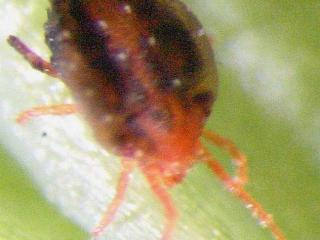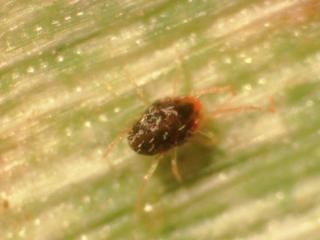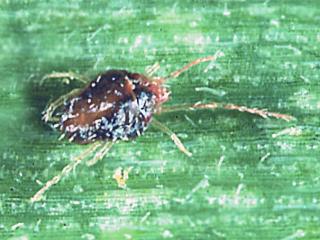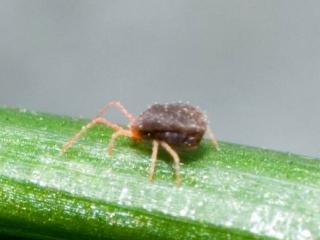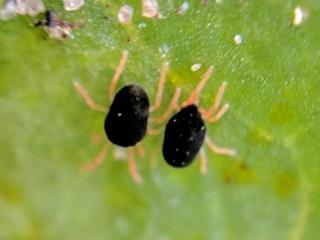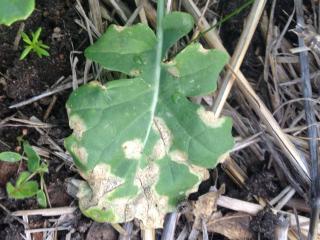Bryobia mites, brown wheat mites and other early season pest activity
Bryobia mites, lucerne flea and vegetable weevils
- Merredin
- Kellerberrin
- Tammin
- Cunderdin
- Meckering
- Wickepin
Joshua Cope (Landmark) reports finding bryobia mites in Bonita canola near Merredin.
Dan Taylor (DKT Rural Agencies) has been finding bryobia mites in emerging canola crops at Kellerberrin, Tammin, Cunderdin and Meckering. In some cases mite numbers and moisture stressed seedlings prompted crops to be sprayed with omethoate. Dan has also seen small numbers of vegetable weevils and lucerne flea at Meckering, but not at damaging numbers.
A user of the Planfarm Herbicide Guide app has also reported bryobia mites on volunteer canola in seeded pastures near Wickepin.
Brown wheat mites
- Mullewa
- Narrogin
- Northern and central areas
There have been some reports to PestFax recently of bryobia mites which, using the photos submitted through the mobile reporter app and physical samples, have been later confirmed as being brown wheat mites (Petrobia latens). Brown wheat mites have been found in Barlock lupins at Mullewa and on volunteer barley near Narrogin.
Brown wheat mites have also been detected in multiple sites in the northern and central agricultural areas by DPIRD staff recently, especially on cereals and lupins.
There are a variety of mite pests that can attack emerging crops and confusingly they have similar dark bodies and reddish legs.
Correct identification of mites is important!
Brown wheat mites can be confused with bryobia mites very easily. This highlights the need for correct identification of mites for effective mite control. To diagnose brown wheat mite from bryobia, have a close look with a hand lens or mobile phone macro lens and you will see that the front legs of brown wheat mites are long like bryobia, the body is more globular like redlegged earth mites and blue oat mites, and the hairs on the body are longer and thinner than bryobia which have shorter thicker hairs which look like the end of a spatula.
Bryobia mites have a flattened ‘pie-dish’ shape body with distinctively long front legs. They prefer warmer conditions.
Redlegged adults are 1mm long with a black body and eight red-orange legs. RLEM have a cold temperature requirement (generally seven days below 16°C average daytime temperatures) before the eggs are triggered to hatch. RLEMs do co-exist with blue oat mites so make sure you correctly identify what mites you are finding. Blue oat mites look similar but have a red dot on their back.
Emerging canola cotyledons and young seedlings can often tolerate low to moderate numbers of mites without sustaining plant losses, especially under good growing conditions. When mite numbers are considerable or seedlings are moisture stressed, correct identification is critical for effective control, as different species can vary in their susceptibility to certain insecticide groups, either naturally or through insecticide resistance. Mites also can be very difficult to identify without the use of a hand lens magnifier or microscope.
Growers and consultants can report or request the identity of mites by using the photo attachment function in the PestFax Reporter app.
Tips on how to correctly identify earth mite pests can also be found at cesar’s Common earth mites of broadacre crops and pastures in southern Australia YouTube video and GRDC’s GRDC Crop Mites Back Pocket Guide.
For insecticide information refer to DPIRD’s 2019 Autumn/Winter Insecticide Guide.
For more information about diagnosing and managing different mites refer to the departments;
- Diagnosing bryobia mite
- Diagnosing brown wheat mite
- Diagnosing blue oat mite
- Diagnosing redlegged earth mite pages.
For more information on invertebrate insects contact Dustin Severtson, Development Officer, Northam on +61 (0)8 9690 2160 or Svetlana Micic, Research Officer, Albany on +61 (0)8 9892 8591.
Are you regularly checking DPIRD’s 2019 canola blackleg spore shower forecasts?
The department's blackleg spore showers forecasts for Western Australia for the 2019 growing season are available online.
Growers are reminded to check the risk of blackleg in their current canola crops and apply appropriate measures to minimize the risk of yield loss.
The DPIRD blackleg sporacle model predicts the onset of blackleg spore release from canola stubble for 26 canola growing districts of Western Australia.
The department’s latest blackleg forecast, which is current to 7 May 2019, is predicting high risk of blackleg in canola in most of the south coastal and some of the great southern regions, moderate risk in the central region and low risk in most of the northern region canola cops.
The blackleg spore shower risk will change each week as the season progresses depending upon the weather conditions in the coming weeks, therefore, growers are urged to check the weekly updates. Refer to the department’s Canola blackleg spore maturity forecast for Western Australia page to check the blackleg sporacle model forecast for your district.
The overall risk of blackleg infection on a property will be determined by factors such as choice of resistant variety, paddock rotation, fungicide usage, distance from previous year’s canola residues and stubble reduction.
To minimise the risk of blackleg infection growers should consider;
- Sowing into paddocks that are out of canola rotation for more than three years.
- Avoiding sowing within 500m of last year’s canola residues.
- Applying seed dressing and fertilizer applied fungicide. Reduced sensitivity to Jockey has been reported in some WA blackleg populations, use caution while applying this fungicide.
- Applying foliar application in case of high disease pressure.
For further details on blackleg management and current blackleg ratings refer to GRDC’s Blackleg Management Guide (2019 autumn variety ratings) and Plan ahead to fight blackleg in canola this season media release.
DPIRD has created a BlacklegCM app. This app is designed to assist growers and consultants to determine the best and most profitable management strategy to reduce blackleg disease and increase profits. To download the BlacklegCM app, go to the App Store or Google Play store from your iPad or Android tablet and search for BlacklegCM or refer to the department's BlacklegCM page.
For more information about blackleg in canola contact Ravjit Khangura, Research Officer, South Perth on +61 (0)8 9368 3374 or Andrea Hills, Research officer, Esperance on +61 (0)8 9083 1144.
For more information about the blackleg sporacle model contact Kawsar Salam, Research officer, South Perth on +61 (0)8 9368 3104.
For more information about the BlacklegCM app contact Art Diggle, Senior Research Officer, South Perth on +61 (0)8 9368 3563.
Free testing available this season for sub clover red leaf syndrome in pastures
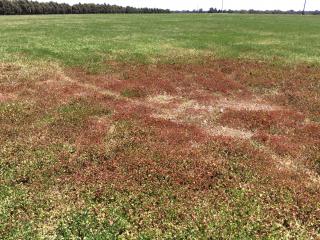
Farmers who suspect that red leaf syndrome is present in their subterranean clover are reminded that free testing is available again this season.
DPIRD and the University of Western Australia (UWA) are keen to test plants with symptoms as part of broader work to better understand this syndrome, which can severely stunt pasture growth.
Sub clover red leaf syndrome symptoms include red leaves, stunted plants and even premature plant death.
The syndrome has occurred in the central and southern agricultural areas of WA for many years, however surveillance was initiated in 2017 after severe losses occurred for the first time in some areas. These areas included Dalwallinu, New Norcia, York, Brookton, Katanning and Mount Barker.
Laboratory testing by the department plus field and glasshouse trials have identified the soybean dwarf virus (SbDV) as the probable cause, with other factors, such as environmental stress and root disease, likely to contribute to the severity of the syndrome.
Managing sub clover red leaf syndrome in 2019
Loss of sub clover production is greatest when the plants are infected by the virus in autumn or early winter.
Soybean dwarf virus is not a seed borne virus but is spread by aphids. If growers can control the aphids there is a good chance they can manage the syndrome.
Autumn control options to consider include spraying for aphids using an anti-feeding insecticide at two and six weeks after sub clover seedlings emerge. This group of insecticides prevents aphids feeding and therefore reduces the risk of virus infection. For more insecticide information refer to DPIRD’s autumn winter insecticide spray guide 2019.
Oats can also be sown as a barrier around pasture paddocks to disperse aphids and slow early spread into pasture from outside sources.
Researchers are yet to find aphids in the Albany region this season and suspect the risk of an outbreak this autumn is low, but farmers that do find the characteristic symptoms in their sub clover are able to have free testing carried out.
How do growers test for SbDV?
To arrange free testing growers are urged to first contact research officers Paul Sanford (DPIRD) or Kevin Foster (UWA).
Samples will then need to be mailed to DPIRD Diagnostic Laboratory Services, Specimen Reception C Block, DPIRD, 3 Baron-Hay Court, South Perth WA 6151.
Growers who provide samples are provided with the test results and management advice.
Affected growers are invited to participate in online survey
Australian Wool Innovation (AWI) continue to host an online producer survey, which enables producers to report incidents and assists the livestock funding bodies to determine the extent of the problem. To contribute to the survey go to the MLA website.
For more information on identifying and managing the sub clover red leaf syndrome refer to DPIRD’s Subterranean clover red leaf syndrome as caused by soybean dwarf virus page.
For more information on managing sub clover contact Paul Sanford, Senior Research Officer, Albany on +61 (0)8 9892 8475 or or Kevin Foster, UWA Pasture Researcher, Nedlands on +61 (0)8 6488 2220.

